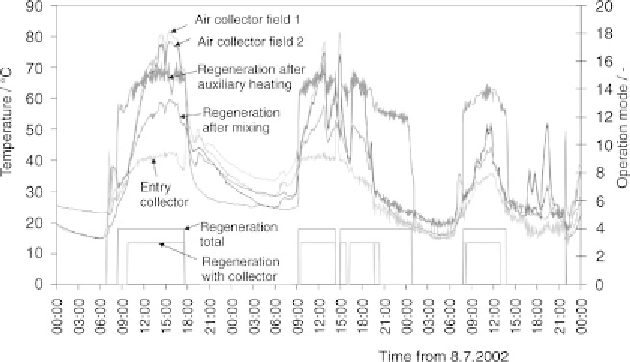Environmental Engineering Reference
In-Depth Information
Figure 5.33
Temperature levels in the regeneration air stream after preheating with waste heat, air
collector heating, mixing of the two volume flows and auxiliary heating. The total operating hours of
regeneration and regeneration with collector heating are also shown
Temporary increases of room humidity could then be reduced when solar energy is
available. To use the solar cooling energy also for long operating hours until midnight
would only be possible if the storage mass of the building itself were used.
The analysis showed that the additional measured auxiliary heating energy demand
mainly occurred on days with rather low ambient air temperatures, when the auxiliary
heating system was on especially in the mornings and evenings. In several cases, free
cooling with a higher supply air volume flow would have been sufficient to cover the
cooling load. In Figure 5.34 it can be seen that the sorption rotor was often switched
on for short time intervals (operating mode
4), which can mainly be attributed to
a heat recovery mode, when the humidifiers decreased the supply air temperature too
quickly.
The total solar fraction for the month is low at 18%. The COP is 33% for all full
regeneration hours, if the cooling energy is calculated from the enthalpy difference
between ambient air entering the machine and room supply air. In the Althengstett
system, a large discrepancy in temperature levels and as a result in COPs was noted
between the ambient air temperature measured with a shaded sensor in the supply air
entry channel on the building roof and the temperature measured in the entry channel
of the machine placed on the ground floor. The machine entry temperature was up
to 6 K lower than the roof air temperature, so that the net cooling effect of the DEC
system was much lower than calculated using ambient air temperature. If the roof
temperature is taken for the COP calculations, the value for full regeneration doubles.
However, this is not due to the DEC system, but rather due to precooling of the ambient
air within the building, indicating that better thermal insulation should be used.
=

Search WWH ::

Custom Search